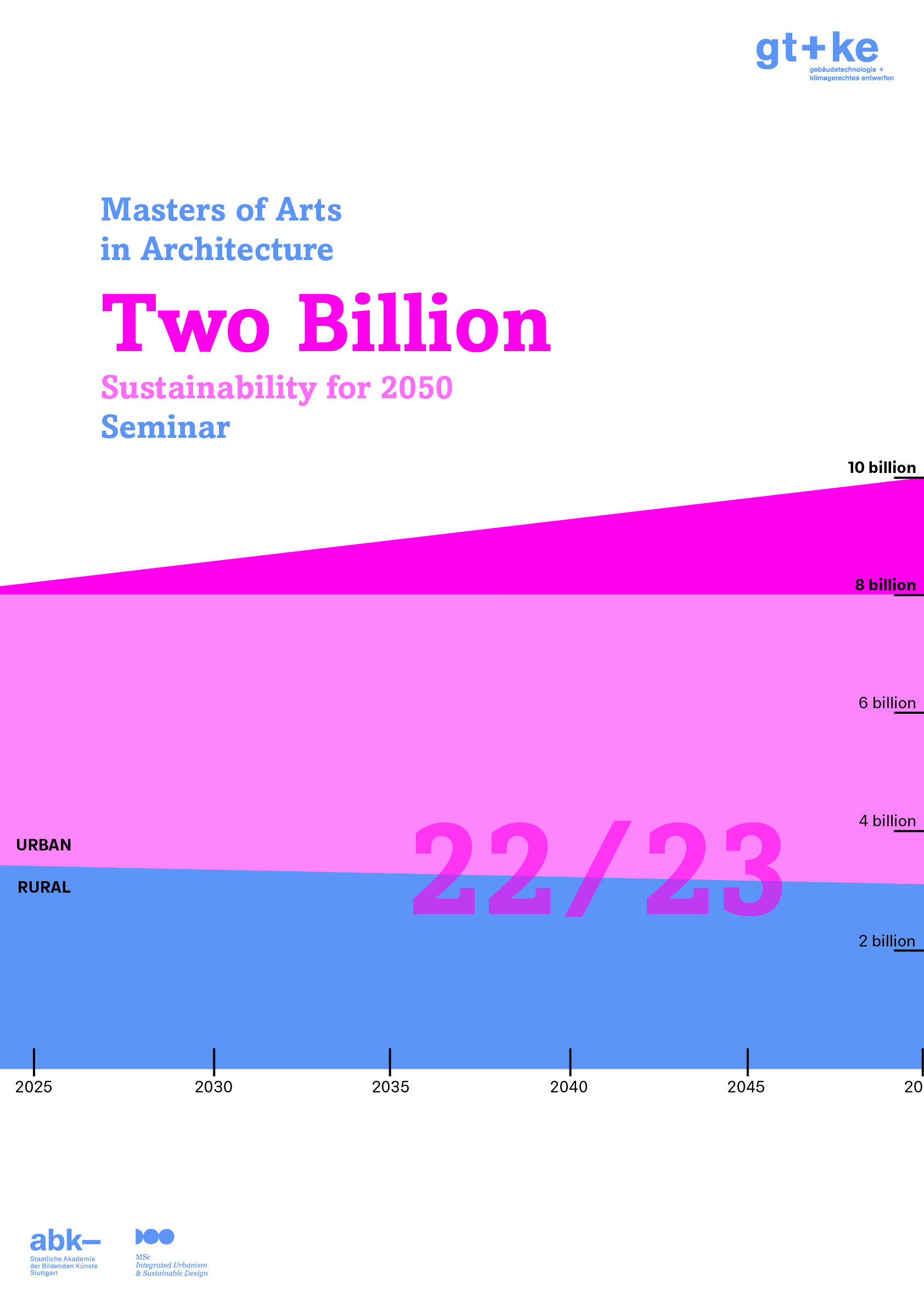| MA Seminar – WS 2022/23 |
Sustainability for 2050 | Klimagerechtes Entwerfen |
Bis 2050 werden zwei Milliarden (Two Billion) mehr Menschen in urbanen Räumen leben im Vergleich zu heute. Um ein solches Wachstum zu bewältigen, müssten wir jede Woche eine Stadt mit 1.4 mio. Einwohnern planen und errichten [1,2,3]. Nachhaltiges Handeln fordert Architekten, Planungsteams und die Bauwirtschaft heraus, dies mit möglichst geringen Umweltauswirkungen und einem immer stärker zu reduzierenden CO2 Ausstoß umzusetzen.
Das MA Seminar legt den Fokus auf das klimagerechte Entwerfen und dessen Planungsprozess im Planungsteam. Innerhalb dieses Prozesses sollen vor dem Hintergrund der obig skizzierten Herausforderungen architektonische Nachhaltigkeitsstrategien in urbanen und dicht besiedelten Räumen entwickelt und exemplarisch planerisch an verschiedenen realen Standorten auf der Welt angewandt werden. Dabei werden zunächst die lokalen Gegebenheiten (Klima, Material und kultureller Hintergrund) analysiert und Entwurfsstrategien zur Erreichung der Nachhaltigkeitszielsetzungen im Bereich Ökonomie, Ökologie und Soziales in Teams entwickelt. Beim Seminar soll die interdisziplinäre Vorgehensweise und der Prozess der Entwurfsfindung dabei im Vordergrund stehen.
Die internationalen Teams, bestehend aus abk-Studierenden und IUSD-Studierenden, werden in mehreren Workshops mit Studierenden der HfT Stuttgart zusammenarbeiten. Die angehenden Klimaingenieure der HfT Stuttgart unterstützen, mit ihrer Expertise und verschiedenen Simulationstools, den integrierten Entwurfsprozess.
Für das Seminar sind keine speziellen Vorkenntnisse erforderlich. Das Seminar kann jedoch als Fortführung der Master Seminare: „Nachhaltiges Bauen“ als auch „Climate Design Tools“ genutzt werden. Es ist ein Joint-Venture-Seminar für MA-Studierende der abk-Stuttgart und MA-Studierende des IUSD-Programms. Der Integrated Urbanism and Sustainable Design (IUSD) ist ein internationaler Masterstudiengang der Universität Stuttgart und der Ain Shams University in Kairo. Das Seminar findet in Kooperation mit der HfT Stuttgart, KlimaEngineering statt.
english:
By 2050, two billion more people than today will be living in urban areas. To handle such growth, we will have to plan and build a city of 1.4 million inhabitants every week [1,2,3]. Acting sustainable, challenges architects, planning teams and the construction industry to realize this with the least possible environ- mental impact whilst CO2 emissions need to be reduced more and more.
The MA course focuses on climate responsive design and its planning process in the planning team. Within this process, against the background of the challenges outlined above, architectural sustainability strategies are to be developed in urban and densely populated areas and applied as examples in various real locations around the world.
Climate Responsive Design takes advantage of the local climate and site conditions to maximize user comfort and to minimize the environmental impact by applying suited passive strategies to inform the design of the built environment. Therefore, it is a process that delivers solutions towards a sustainable built environment and has a high relevance on the design itself. Applying climate responsive design principles in the design process leads to buildings that inherently contribute to the local architecture and cultural identity and differentiates itself from globalized architecture.
Within this context, the main emphasis of the seminar is the investigation on the interplay between location, ecology, material, space and form. Starting point is the analysis of the local climate, the culture, and the local availability of resources. In workshops the interdisciplinary teams develop urban and building design responding to various climatic contexts. The objective is to enable an intuitive access to the climate-responsive design methodology and to deepen the understanding for challenges and opportunities of ecology, building technology and building physics aspects in the build environment.
The seminar is set-up as an interdisciplinary and international education and ideas platform bringing various disciplines and students together to work as a team to develop a climate responsive design for a specific site.
MA architecture students from the Stuttgart State Academy of Art and Design (abk-) will work together with students from the IUSD MSc program (Course: Sustainable Architecture I) of the University of Stuttgart. They both will collaborate in mixed teams with the KlimaEngineering Students from the HfT Stuttgart, who will support the integrated design process with the help of their expertise and various simulation tools. Multiple team workshops along the design process will facilitate the exchange and cooperation.
Klasse und kooperierende Studiengänge:
www.gt.abk-stuttgart.de | www.iusd.uni-stuttgart.de | www.hft-stuttgart.de
Anmeldung:
via e-mail: christian.degenhardt@abk-stuttgart.de
Erster Termin: Freitag, 21. Oktober 2022, 16.00 Uhr
Studiozeiten: Do. tbd (Online) / Fr. 14.00 -16.00 Uhr
Hybrid: Online und Neubau 1: Raum HS 301
Seminar Details:
ECTS: 5 | Language: English
This course is a collaboration between the ABK Stuttgart, Master of Architecture program and the IUSD MSc program of the University of Stuttgart.
Master of Arts in Architecture Seminar – Sondergebiete des klimagerechten Bauens, Lehrangebot Schwerpunkt Design_Technologie
Klasse für Gebäudetechnologie und Klimagerechtes Entwerfen | Building Technology and Climate Responsive Design, ABK Stuttgart | Prof. Dipl.-Ing. Matthias Rudolph, AM Roman Schallon M.Sc. M.Eng. Dipl.-Ing.(FH) and Dipl.-Ing. Christian Degenhardt, Visiting Lecturer, IUSD, University of Stuttgart
Quellen: Soure for diagramm: OWID based on UN World Urbanization Prospects 2018 and historical sources
[3] https://ourworldindata.org/grapher/urban-and-rural-population-2050?country=~OWID_WRL
